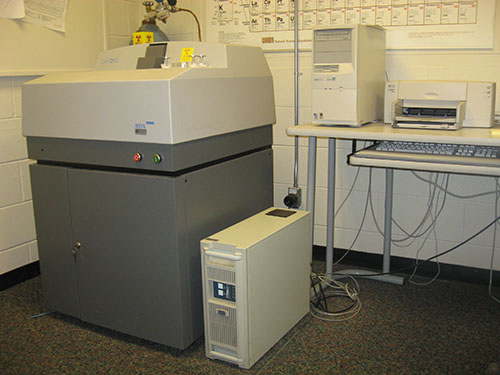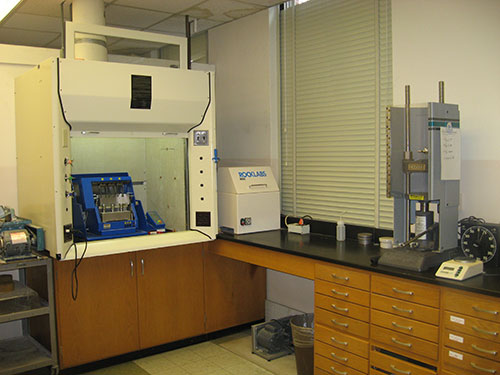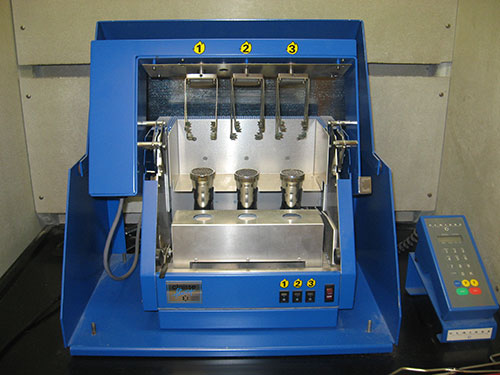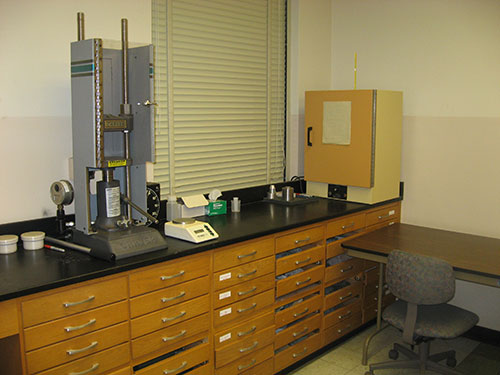MTDXRF Laboratory
 The Middle Tennessee State University Department of Geosciences an X-ray fluorescence
laboratory which is available for academic, government, and private industry uses.
The laboratory utilizes an Oxford Instruments MDX 1080+ multi-dispersive X-ray fluorescence (MDXRF) spectrometer, acquired in Spring 2000,
with grant monies provided by the National Science Foundation Division of Undergraduate Education.
The Middle Tennessee State University Department of Geosciences an X-ray fluorescence
laboratory which is available for academic, government, and private industry uses.
The laboratory utilizes an Oxford Instruments MDX 1080+ multi-dispersive X-ray fluorescence (MDXRF) spectrometer, acquired in Spring 2000,
with grant monies provided by the National Science Foundation Division of Undergraduate Education.
MDXRF is an elemental analysis method that combines classical techniques of wavelength dispersive and energy dispersive X-ray fluorescence, allowing high performance measurements to be made on low to high atomic number elements (Alumina to Uranium) in a variety of sample types. The MDX 1080+ is equipped for multi-elemental semi-quantitative (standardless) and quantitative analysis of both solids and liquids. Applications for MDXRF include materials such as cement, rock, minerals, soils, plastics, glass, metals and ceramics.
An important goal of the MTSU XRF laboratory is to provide undergraduate students the opportunity to participate in geochemical sample preparation and analysis. Accordingly, most sample preparations and analyses are performed by MTSU undergraduate students under the supervision of Department of Geosciences faculty. Visiting undergraduate and graduate students from other colleges and universities are welcome to use the sample preparation and MDXRF laboratory facilities. Although the lab does impose modest charges to cover sample preparation and analysis expenses, costs are considerably lower than those charged by commercial analytical laboratories.
In addition to analysis of naturally occurring earth materials (e.g. minerals, rocks, soils), the lab especially welcomes academic users interested in application of X-ray fluorescence technology to problems in cultural geography, archeology, and anthropology. Students in the social sciences are encouraged to use the laboratory to explore ways in which MDXRF analysis can be used to solve research problems within their own academic fields of interest.
Laboratory Facilities
Oxford Instruments MDX 1080+ XRF Spectrometer |
XRF Sample Preparation Lab |
|
Claisse XRF Sample Fusion System  |
XRF Sample Preparation Lab |
Oxford Instruments MDX 1080+ Specifications
| Analysis Method: | Multi-Dispersive X-Ray Fluorescence |
| Element Range: | Alumina to Uranium |
| Concentration Range: | ppm to 100% |
| Sample Form: | Solids, Liquids, Powders, Glasses, Granules |
| X-Ray Detection: | |
| Fixed Channels: | Na, Mg, P, Ba, Rb, Y, Nb, K, Ca (Quantitative Analysis) |
| Flexi-Channel: | Al to U (Quantitative and Semi-Quantitative Analysis) |
| X-Ray Excitation: | Medium Power 200W, 40/50 kV End Window Rh X-Ray Tube |
| Sample Preparation: | Pulverizing, Pelletizing, Fusion |
For additional information regarding MTSU MDXRF laboratory capabilities and analytical
costs, please contact Dr. Warner Cribb.
Faculty Spotlight
Click the image above to see a larger version.
Dr. Mark Abolins teaches a course about earthquakes and folded and fractured rocks (Geol 4080/5080 Structural Geology), a Field Methods in Geology course (Geol 3050), and an on-line course about caves (Geol 3040 Geoscience of Caves). His research foci include (a) the development of caves within folded and fractured rocks, (b) the geology of continental interiors, and (c) the accuracy of geologic maps. In the computer sphere, he uses geographic information system (GIS) software and Midland Valley MOVE structural geology software in teaching and research. He has incorporated state-of-the-art local and global LiDAR (light detection and ranging) elevation datasets into his work.



